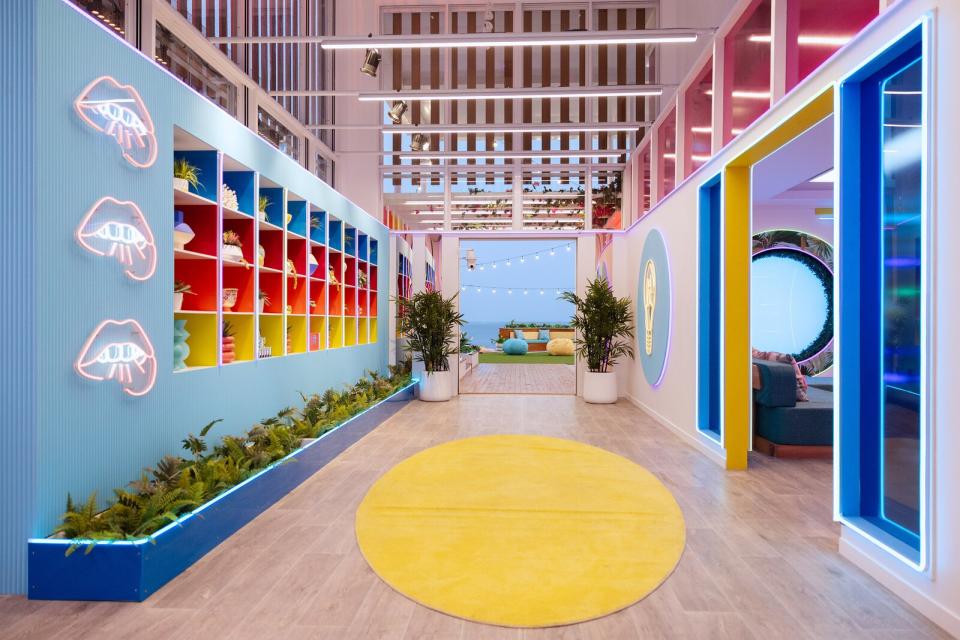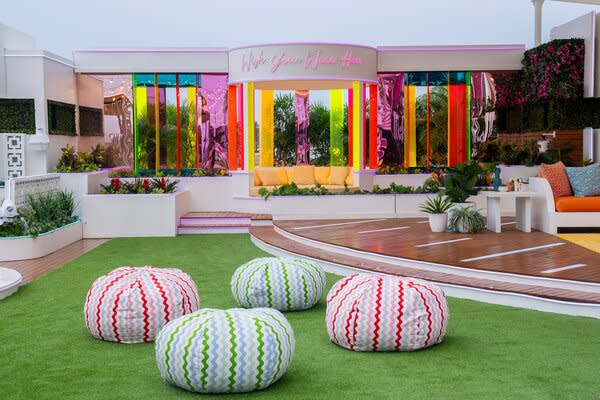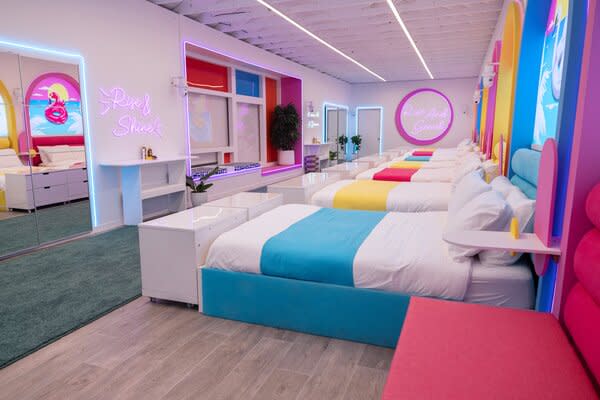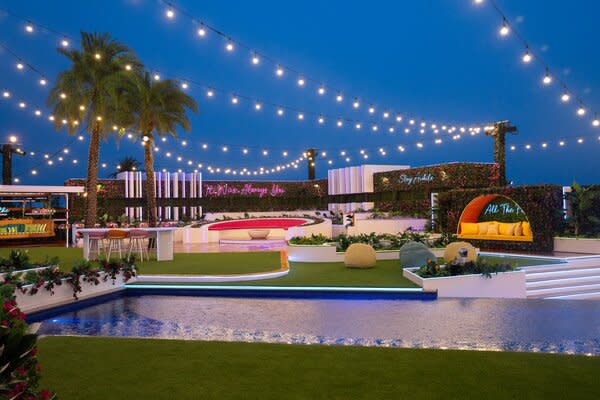How Do You Design a Villa Fit for Finding Love on Reality TV?
- Oops!Something went wrong.Please try again later.
"Love Island USA" production designer Richard Jensen discusses what goes into shaping the covetable mansions where the dating shows are filmed. Hint: It’s not just about shoving eight queen-size beds into one big, well-lit room.

When The Real World launched in 1992, it introduced the world to the concept of the reality show residence. Typically massive and festooned with all sorts of kooky, camera-pleasing design elements, the show’s mansions, lofts, and soundstages became a cultural touchpoint. As years passed and shows like Big Brother, Jersey Shore, and The Bachelor emerged to wild acclaim—or at least fascination—it became increasingly clear that the viewing public just adores watching hot, charismatic people thrown together under one roof.
The latest cultural obsession making hay with this format is Love Island, which first aired in the U.K. years before its American spinoff, wherein 15 or so buff, remarkably un-self-conscious twenty-somethings are sent off to live in a house/set in some temperate location. (This year, for Love Island USA’s fifth season, it’s Fiji.) There, the gaggle of lithe gals and tatted up dudes—all typically clad in very tiny swimwear—are tasked with forming meaningful, loving relationships with one another. Sure, they have to watch their crushes make out with their supposed friends on a daily basis as part of mini-challenges where kissing is a common reward, but that’s all part of the experience. What long-lasting relationship hasn’t experienced some ups and downs amid a dazzling array of neon signs, hot tubs, and heart-shaped showers?
As production designer for the American Love Island series, Richard Jensen is tasked with creating the show’s colorful home/set, which is typically an eye-popping melange of brightly colored fabrics, cozy spots to chat or cuddle, and artfully arranged string lights. As all of the contestants sleep in the same room, paired up in couples, Jensen has to figure out how to fit eight queen-size beds in one enormous bedroom each season. He also has to create changing rooms, intimate hideaways, and a big—but not too big—fire pit area, where the group meets with their celebrity host to decide who’s just making the romantic grade. He has to think about camera angles, cyclone preparedness, and durable, self tanner-resistant outdoor fabrics, and he has to build the entire set—bedrooms, bathrooms, kitchen, pool area, and all—in just about six weeks. And did we mention that, this year, he had to do it in Fiji? Is there even an Ikea there?
Fortunately for Jensen, he has some reality TV experience. A veteran of shows like Bachelor in Paradise, Dating Around, and The Bachelorette: Australia, Jensen has spent well over a decade turning nice but perfectly livable homes into sumptuous, covetable, and very well-lit paradises. He says that working on The Bachelor can feel like an interior design job compared to the technical, production-heavy work of Love Island, in part because of the latter’s reliance on remote cameras. While The Bachelor is filmed with camera crews roaming the grounds of whatever estate they’re set up on, Love Island uses more than 80 remote cameras set around the house to capture the action, as well as manned cameras hidden away inside 50- to 80-foot-long hollow sections of wall. The goal, Jensen says, is to make the so-called "islanders" feel as at home as possible so they can fully succumb to the experience.
And what a storied experience it is. First launched on the U.K.’s ITV in 2005, Love Island has become a global phenomenon. In England, it’s often the most watched show for 18- to 34-year-olds, and overall, it’s spawned more than 20 international versions, including Love Island Nigeria, Canada’s L’ile de l’amour, and Love Island Albania. While each version has its own look, many pull heavily from the aesthetic of the British original, including Jensen’s American Love Island. "The show has an instantly recognizable aesthetic and historically in the U.K. that has meant crisp whites and bright, poppy colors," Jensen says. "When I started working on the U.S. version, I took inspiration from that. The best thing for a TV show is when you can swipe through listings and know instantly what show you’re looking at just based on the whole look. That’s why that original style was really important for us to keep."
That doesn’t mean Jensen hasn’t put his own spin on things. This year, for instance, the villa boasts about 7,000 square feet of colored and mirrored plexiglass, including a full array in both the entry and a cozy little nook the show calls "the snug." Because Love Island is a "fun summer show," Jensen says, "the design of the villa needs to reflect that, and make it feel like it’s somewhere young people want to hang out and have fun and feel sexy."
"The first day when the cast arrives in the villa, it’s always very gratifying to watch them walk in and squeal and yell about all the different bits that they see," Jensen says. "They love having a heart-shaped shower and all these little almost Instagrammable moments all around, which make them feel like they’re living in this sexy villa fantasy. "
For this summer’s location, that meant putting over 25 shipping containers full of set dressing on a boat bound for Fiji, where Jensen and his army of 80-plus staffers started to piece it all together. He sourced fabrics from his native Australia and enlisted local artisans to make furniture and screen print last-minute designs, all in service of making great TV. This year, he even had to find someone to make a comically large "Christmas car commercial"-style bow for the season opener, which he sourced last minute from a local upholsterer who figured out how to do it in about three hours and charged the team just $100.
"I have to be very careful about how I place everything. A lot can happen behind a plant, lamp, or pillow."
Before cameras roll, members of the Love Island crew spend about a week living in the house, going about their business so that Jensen and the directors can make sure that, other than the space around the toilet, there’s no spot the cameras can’t see. "As a residential designer, you can walk into a house and create what's pleasing to your eye, but we have to consider what’s pleasing to the camera," Jensen says. "I have to make sure there’s no funny corner where two people could go for some privacy."
The robotic cameras the show uses mean that Jensen also has to be deliberate about furniture placement. "I have to be very careful about how I place everything, because if an item is a little bit too tall, when the camera comes around, all of the sudden that item can be blocking the shot," he says. "A lot can happen behind a plant, lamp, or pillow."
Even when cameras are rolling, Jensen’s team is responsible for making sure the house looks shipshape at all times. That means sneaking into living spaces at 5 a.m., before the cast is awake, to fluff pillows and put everything back in its ideal spot. When the cast goes outside to eat breakfast, those same people sneak into the group’s sleeping area to make beds and change sheets. When it comes time to replenish the cast’s cereal, candy, or other dry goods, that’s done through what Jensen calls "the magic pantry," which has a door both at the front and at the back. "We try and minimize how much we’re on set so the cast feels like it's their villa and forgets that there's people around," he says.
See the full story on Dwell.com: How Do You Design a Villa Fit for Finding Love on Reality TV?
Related stories:




